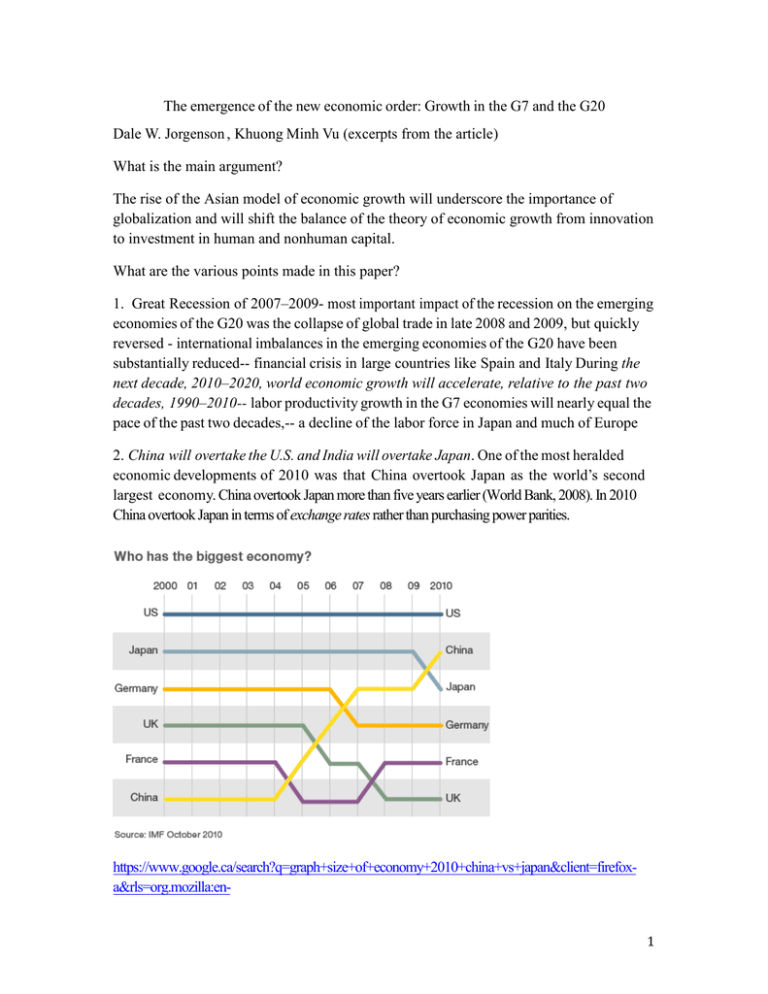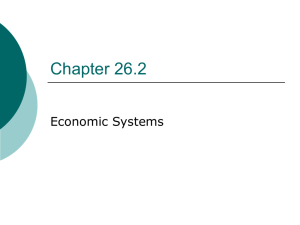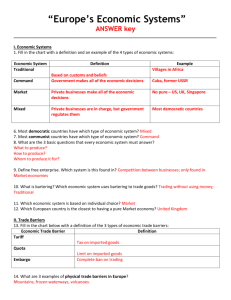Jorgenson-Vu
advertisement

The emergence of the new economic order: Growth in the G7 and the G20 Dale W. Jorgenson , Khuong Minh Vu (excerpts from the article) What is the main argument? The rise of the Asian model of economic growth will underscore the importance of globalization and will shift the balance of the theory of economic growth from innovation to investment in human and nonhuman capital. What are the various points made in this paper? 1. Great Recession of 2007–2009- most important impact of the recession on the emerging economies of the G20 was the collapse of global trade in late 2008 and 2009, but quickly reversed - international imbalances in the emerging economies of the G20 have been substantially reduced-- financial crisis in large countries like Spain and Italy During the next decade, 2010–2020, world economic growth will accelerate, relative to the past two decades, 1990–2010-- labor productivity growth in the G7 economies will nearly equal the pace of the past two decades,-- a decline of the labor force in Japan and much of Europe 2. China will overtake the U.S. and India will overtake Japan. One of the most heralded economic developments of 2010 was that China overtook Japan as the world’s second largest economy. China overtook Japan more than five years earlier (World Bank, 2008). In 2010 China overtook Japan in terms of exchange rates rather than purchasing power parities. https://www.google.ca/search?q=graph+size+of+economy+2010+china+vs+japan&client=firefoxa&rls=org.mozilla:en1 US:official&channel=np&biw=1231&bih=803&tbm=isch&imgil=6nUBNk0GipMt1M%253A%25 3Bo5ivzBIc3TTCfM%253Bhttp%25253A%25252F%25252Fwww.china-mike.com%25252Ffactsabout-china%25252Feconomy-investment-businessstatistics%25252F&source=iu&pf=m&fir=6nUBNk0GipMt1M%253A%252Co5ivzBIc3TTCfM%2 52C_&usg=__H2Lcq4lLNjZ5GkGKzeJHds6AGJs%3D&ved=0CEEQyjc&ei=ZSEfVKvpKMb2y QT6nYGgAg#facrc=_&imgdii=_&imgrc=rRUUSMHV1aKsKM%253A%3BTw4ArMSJ8BV6P M%3Bhttp%253A%252F%252Fwww.bbc.co.uk%252Fnol%252Fshared%252Fbsp%252Fhi%252 Fdhtml_slides%252F11%252Fchinajapan%252Fimg%252Fslide4.gif%3Bhttp%253A%252F%252Fwww.bbc.co.uk%252Fnews%252F business-12427321%3B464%3B375 In 2012 India overtook Japan in terms of purchasing power parity and will continue to grow much more rapidly. see https://www.cia.gov/library/publications/the-worldfactbook/rankorder/2001rank.html see list of countries by size of economies: http://en.wikipedia.org/wiki/List_of_countries_by_GDP_%28nominal%29 Purchasing Power Parity (PPP) ref: http://en.wikipedia.org/wiki/Purchasing_power_parity#Range_and_quality_of_goods The goods that the currency has the "power" to purchase are a basket of goods of different types: Local, non-tradable goods and services (like electric power) that are produced and sold domestically. Tradable goods such as non-perishable commodities that can be sold on the international market (like diamonds). The more that a product falls into category 1, the more its price will be from the currency exchange rate, moving towards the PPP exchange rate. Conversely, category 2 products tend to trade close to the currency exchange rate. (See also Penn effect). More processed and expensive products are likely to be tradable, falling into the second category, and drifting from the PPP exchange rate to the currency exchange rate. Even if the PPP "value" of the Ethiopian currency is three times stronger than the currency exchange rate, it won't buy three times as much of internationally traded goods like steel, cars and microchips, but non-traded goods like housing, services ("haircuts"), and domestically produced crops. The relative price differential between tradables and non-tradables from high-income to low-income countries is a consequence of the Balassa–Samuelson effect and gives a big cost advantage to labour-intensive production of tradable goods in low income countries (like Ethiopia), as against high income countries (like Switzerland). 3. The International Monetary Fund’s World Economic Outlook for October 2012 calls for parity between the two economies in 2017 in terms of purchasing power and our projections agree (International Monetary Fund, 2012). However, the U.S. and China 2 made up more than a third of the world economy in 2010 and this proportion will increase by 2020, consolidating the rise of the G2, China and the U.S., as the world’s leading economies. Russia will overtake Germany and Brazil will overtake the U.K., leading to a New Economic Order in 2020: China, the U.S., India, Japan, Russia, Germany, and Brazil 4. Major changes in the growth rate of the world economy. The period 1995–2000 witnessed a major acceleration in world economic growth. World growth further accelerated during 2000–2005. measuring capital input - IT cap vs non-IT capital, labour: hours vs. quality, labour quality is human cap accumulated through education and experience. 5. Econ growth occurs through: 2 different processes: a. Replication of existing technologies by hiring more workers and greater cap investment. Growth of output increases in proportion to the growth of input, so that there is no contribution of growth in total factor productivity, the ratio of output to input. b. Innovation –changes in technology. Innovation holds out the promise of achieving increases in output that exceed the growth of inputs, so that total factor productivity (TFP ) rises. Replication far outstrips innovation as a source of economic growth, as shown in Fig. 1. total-factor productivity (TFP), also called multi-factor productivity, is a variable which accounts for effects in total output not caused by traditionally measured inputs of labor and capital. If all inputs are accounted for, then total factor productivity (TFP) can be taken as a measure of an economy’s long-term technological change or technological dynamism. TFP cannot be measured directly. Instead it is a residual, often called the Solow residual, which accounts for effects in total output not caused by inputs. 6. World economic growth has undergone a powerful revival since 1995 (see Fig. 2). The GDP growth rate jumped more than a full percentage point from 2.20 percent during 1990–1995 to 3.35 percent in 1995–2000 and then to 3.63 percent in 2000–2005. In 2005–2010 growth of GDP in the advanced countries of the G7 was slowed considerably by the financial and economic crisis of 2007–2009. The growth of world GDP decelerated to 3.30 percent. The world-wide financial and economic crisis of 2007–2009 opened a wide gap between actual output for the U.S. and other G7 economies and potential output, determined by supplies of capital and labor inputs and productivity The GDP growth of 2.20 percent doubles world output every 32 years, while 3.63 percent growth doubles world output in less than 19 years. 7. The actual level of output reflects the deficiency of aggregate demand that accompanied 3 the crisis. 8. In US: due to capital deepening, increases in capital input per hour worked, especially during the information technology boom of 1995–2000. Growth in total factor productivity revived-- growth of U.S. GDP has been more rapid than that of any other economy in the G7 with only Canada close behind --2005–2010, largely due to the emergence of a gap between potential and actual GDP during the Great Recession. Fig. 3 we analyze the sources of economic growth of the G7 during 1990–2010. Among the members of the G7 Germany had the strongest economic performance during the Great Recession with positive growth in total factor productivity and hours worked. Japan’s productivity growth revived 9.China sustained double-digit economic growth throughout the decade 2000–2010 with only a slight deceleration during the Great Recession, as shown in Fig. 4. India’s growth rate rose steadily during the two decades 1990–2010. For both China and India capital input contributed more to economic growth than total factor productivity growth during these decades 3. Projecting economic growth, 2010–2020 10. The driving forces in future economic growth are demography and technology. We limit our projections to potential economic growth, leaving projections of actual growth to forecasters like the IMF with more country-specific information. We have incorporated trends in demography and technology in the major countries. For example, the growth of the Japanese population and labor force will continue to be negative and France, Germany, Italy, Russia and South Korea will also began to experience negative labor force growth. The growth of the Chinese labor force will decline substantially and India’s population will grow much more rapidly than China’s. 11. Growth of the world economy will accelerate during 2010–2020, as shown in Fig. 7. The U.S. will continue to outperform the other members of the G7 due to expansion of the labor force and growth of hours worked. Labor productivity growth in Germany, Japan, and the U.K. will be stronger than in the U.S., but the rate of decline in the Japanese labor force will reach almost one percent per year. The German labor force will also decline, but less rapidly, while the U.K. labor force will be essentially unchanged. Italy will continue to lag in economic growth among the G7 economies, but Italian growth will be positive for 2010–2020. Fig. 9. Growth rates in China will fall- remain 7.5 percent per year, well above the pace needed to overtake the U.S. by 2020. 4 India’s growth rate will rise to 6.5 percent, which is insufficient to avoid a considerable fiscal consolidation. The size of the Russian economy will nearly double within two decades and Russia will overtake Germany by 2015. Brazil will grow less rapidly than the world economy, but will overtake the U.K. in 2012 China’s double-digit growth for the past three decades has produced sizeable imbalances, both internal and external. The ratio of investment to GDP has risen to historic highs, but is leveling off or even falling. External imbalances leading to China’s continuing accumulation of foreign exchange to preserve the dollar exchange rate of the Chinese currency are also reaching a plateau. The real exchange rate of the yuan is rising –china is moving toward slower, but more sustainable growth. 4. New economic order 2020 Fig. 10 summarizes the New Economic Order that will emerge by 2020. China will displace the U.S. as the world’s leading economy, but the G2, China and the U.S., will increase in relative importance in the world economy. India will also rise in relative importance in the world economy, but will remain substantially behind the two leading economies Japan, Russia, Germany and Brazil, which round out the leading seven economies, will all decline in size relative to the world economy. The Rise of Asia will continue with continued rapid growth in Indonesia, South Korea, and other leading Asian economies. The emergence of Asia from the underdevelopment that persisted until the middle of the last century is the great economic achievement of our time This has created a new model for economic growth built on globalization and the patient accumulation of human and nonhuman capital over decades. The new growth paradigm places a premium on skillful management by public and private authorities. The performance of the leading countries in developing this paradigm – first Japan, then the Asian Tigers, and now China and India – has changed the course of economic development in Asia and around the world. 5 Japan, the United States, and other industrialized countries will remain far in advance of China and India in terms of per capita GDP. But the experience of Japan and the four Asian Tigers tells us the advanced economies can emerge outside Europe and North America but this will be measured in decades rather than years. The theory of economic growth has put enormous weight on innovation, which plays a relatively modest role in world economic growth. This view has neglected investment in human and nonhuman capital, which is more important for advanced economies as well as emerging economies. The New Economic Order will focus much more attention to the Asian model of economic growth. http://en.wikipedia.org/wiki/List_of_countries_by_GDP_%28nominal%29 see, size of economies 6








